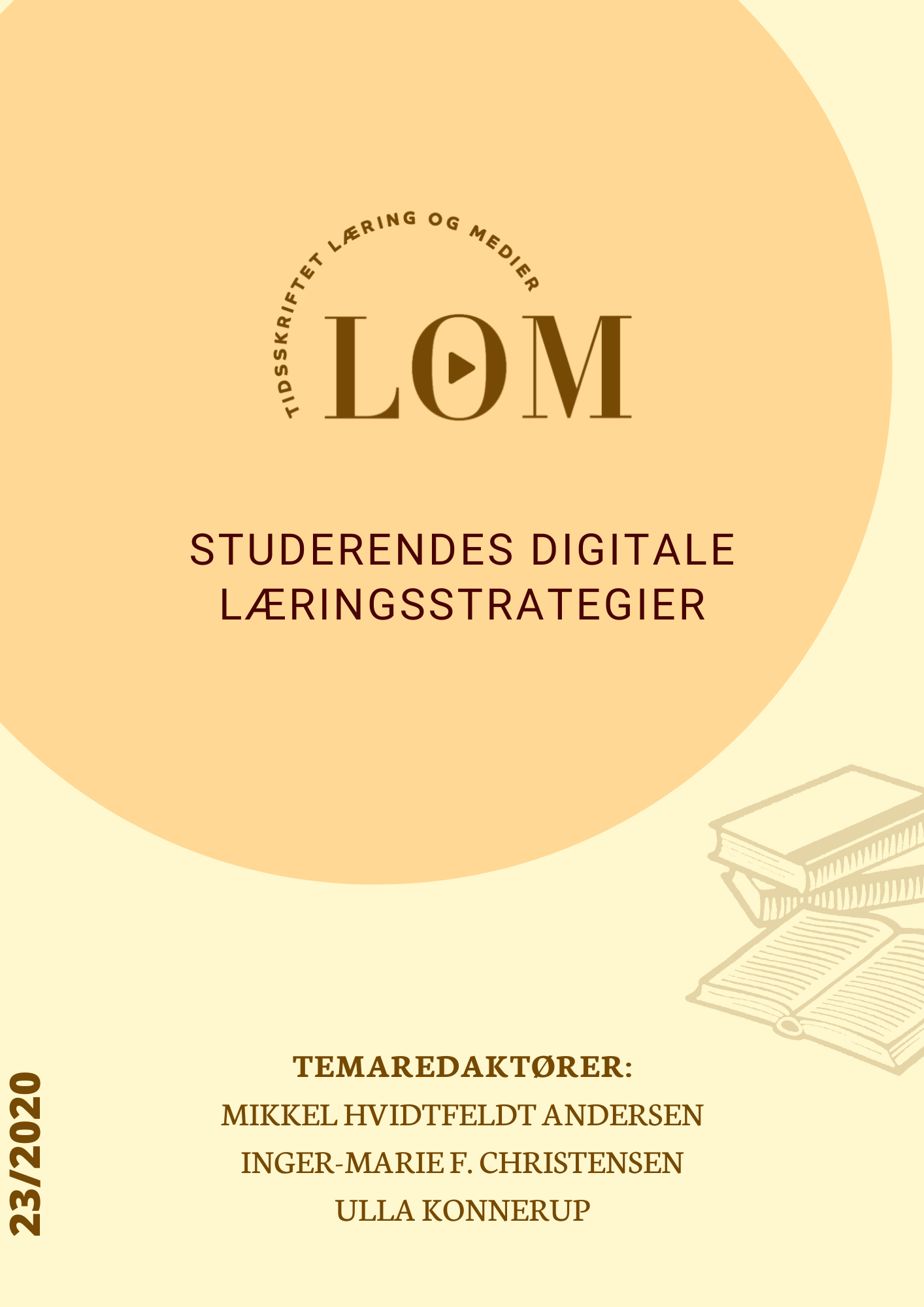Læringsstrategier på ungdomsuddannelserne
En undersøgelse af mønstre i læringsstrategier i en periode med virtuel og blended learning
DOI:
https://doi.org/10.7146/lom.v13i23.121989Nøgleord:
digitale læringsstrategier, Hybride læringsstrategier, digitale ressourceøkologierResumé
Formålet med denne artikel er at identificere mønstre i gymnasieelevers gengivelser af egne læringsstrategier. Situation i sensommeren og efteråret 2020 tilbød muligheder for at undersøge elevernes oplevelser af forløb, der vekslede mellem blended learning, virtuel undervisning og hybride formater. Det viste sig, at eleverne beskrev deres håndtering af udfordringerne og mulighederne meget forskelligt - og at beskrivelserne afspejler strategiske handlemønstre.
Med udgangspunkt i et teoretisk rammeværk, der muliggør undersøgelse af læringsstrategier i et økologisk perspektiv, opstilles to forskningsspørgsmål: 1) Hvilke dimensioner anvender eleverne i deres selvfremstilling af egne læringsstrategier? Og 2) Hvilke læringsstrategiske mønstre kan identificeres?
Artiklens metode udgøres af abduktive sekvenser, der veksler mellem teoretisk rammesætning, tematiske analyser af elevernes selvfortællinger samt ’kontrol-interviews’, der validerer de identificerede dimensioner og mønstre.
Undersøgelsen afslører, hvordan eleverne fremstiller de forskellige – digitale og ikke-digitale – ressourcedimensioner i håndteringen af hybride uddannelseskontekster. Afslutningsvis opsummeres de studerendes læringsstrategiske selvforståelser i fem sammenhængende mønstre af læringsstrategier.
Downloads
Referencer
Anderson, T., & Dron, J. (2014). Teaching Crowds: Learning and Social Media. Athabasca University Press. https://doi.org/10.15215/aupress/9781927356807.01
Brinkmann, S. (2006). John Dewey—En introduktion (Vol. 2006). Hans Reitzel.
Cano, F. (2006). An In-Depth Analysis of the Learning and Study Strategies Inventory (LASSI). Educational and Psychological Measurement, 66(6), 1023–1038. https://doi.org/10.1177/0013164406288167
Caviglia, F., Dalsgaard, C., Davidsen, J., & Ryberg, T. (2018). Studerendes digitale læringsmiljøer: Læringsplatform eller medieøkologi? Tidsskriftet Læring Og Medier (LOM), 10(18). https://doi.org/10.7146/lom.v10i18.96928
Dalsgaard, C., Caviglia, F., Boie, M., Færgemann, H., & Thomsen, M. (2020). Digitale kompetencer i gymnasiet. Aarhus Universitet. (Scientific No. 2486895359). Aarhus Universitet. https://www.forskningsdatabasen.dk/en/catalog/2486895359
Damberg, E. (Ed.). (2014). Gymnasiepædagogik: En grundbog (2. udg., 2. opl). Reitzel.
Darsø, L. (2019). Innovationspædagogik: Kunsten at fremelske innovationskompetence. Samfundslitteratur.
Goodyear, P. (2020). Design and co‐configuration for hybrid learning: Theorising the practices of learning space design. British Journal of Educational Technology, 51(4), 1045–1060. https://doi.org/10.1111/bjet.12925
Hattie, J. (2010). Visible learning: A synthesis of over 800 meta-analyses relating to achievement (Reprinted). Routledge.
Hattie, J. A. C., & Donoghue, G. M. (2016). Learning strategies: A synthesis and conceptual model. Npj Science of Learning, 1(1), 16013. https://doi.org/10.1038/npjscilearn.2016.13
Hattie, J., Hodis, F. A., & Kang, S. H. K. (2020). Theories of motivation: Integration and ways forward. Contemporary Educational Psychology, 101865. https://doi.org/10.1016/j.cedpsych.2020.101865
Hattie, J., & Timperley, H. (2007). The Power of Feedback. Review of Educational Research, 77(1), 81–112. https://doi.org/10.3102/003465430298487
Hietajärvi, L. V. O., & Maksniemi, E. (20017). How to Design Engaging Educational Solutions? , 1–22.
Hodgson, V., & McConnell, D. (2019). Networked Learning and Postdigital Education. Postdigital Science and Education, 1(1), 43–64. https://doi.org/10.1007/s42438-018-0029-0
Holm Sørensen, B., & Tweddell Levinsen, K. (2019). Den hybride skole: Læring og didaktisk design, når det digitale er allestedsnærværende. Klim.
Kahneman, D. (2012). Thinking, fast and slow. Penguin Books.
Kali, Y., McKenney, S., & Sagy, O. (2015). Teachers as designers of technology enhanced learning. Instructional Science, 43(2), 173–179. https://doi.org/10.1007/s11251-014-9343-4
Kikas, E., & Jõgi, A.-L. (2016). Assessment of learning strategies: Self-report questionnaire or learning task. European Journal of Psychology of Education, 31(4), 579–593. https://doi.org/10.1007/s10212-015-0276-3
Kirschner, P. A., & Hendrick, C. (2020). How Learning Happens: Seminal Works in Educational Psychology and What They Mean in Practice (1st ed.). Routledge. https://doi.org/10.4324/9780429061523
Knox, J., Williamson, B., & Bayne, S. (2020). Machine behaviourism: Future visions of ‘learnification’ and ‘datafication’ across humans and digital technologies. Learning, Media and Technology, 45(1), 31–45. https://doi.org/10.1080/17439884.2019.1623251
Laurillard, D. (2012). Teaching as a design science: Building pedagogical patterns for learning and technology. Routledge.
Luckin, R. (2010). Re-designing learning contexts: Technology-rich, learner-centred ecologies. Routledge.
Luckin, R. (Ed.). (2018). Enhancing learning and teaching with technology: What the research says. UCL Institute of Education Press.
Mathiasen, H. (2020). Digitale teknologier i dansk universitetsundervisning: - Et didaktisk perspektiv. Dansk Universitetspaedagogisk Tidsskrift, (28), [1]. Dansk Universitetspaedagogisk Tidsskrift. 28, 1., 28(1), 1–5.
Networked Learning Editorial Collective (NLEC). (2020). Networked Learning: Inviting Redefinition. Postdigital Science and Education. https://doi.org/10.1007/s42438-020-00167-8
Paulsen, M., Tække, J., & Digitalt Understøttet Faglighed og Almendannelse (projekt). (2019). Digitalt understøttet faglighed og almendannelse. Unge Pædagoger.
Rigney, J. W. (1978). Learning Strategies: A Theoretical Perspective11 (pp. 165–205). Elsevier. https://doi.org/10.1016/B978-0-12-526650-5.50012-5
Segal, J. W., Chipman, S. F., & Glaser, R. (Eds.). (1985). Thinking and learning skills. L. Erlbaum.
Selwyn, N. (2019). Should robots replace teachers? AI and the future of education. Medford, MA, USA : Polity Press.
Selwyn, N., Hillman, T., Eynon, R., Ferreira, G., Knox, J., Macgilchrist, F., & Sancho-Gil, J. M. (2020). What’s next for Ed-Tech? Critical hopes and concerns for the 2020s. Learning, Media and Technology, 45(1), 1–6. https://doi.org/10.1080/17439884.2020.1694945
Thomas, P. R., & Bain, J. D. (1984). Contextual dependence of learning approaches: The effects of assessments. Human Learning: Journal of Practical Research & Applications, 3(4), 227–240.
Vermunt, J. D., & Donche, V. (2017). A Learning Patterns Perspective on Student Learning in Higher Education: State of the Art and Moving Forward. Educational Psychology Review, 29(2), 269–299. https://doi.org/10.1007/s10648-017-9414-6
Downloads
Publiceret
Citation/Eksport
Nummer
Sektion
Licens

Artikler publiceret i Tidsskriftet for Læring og Medier er licenseret under en Creative Commons Navngivelse-IkkeKommerciel-IngenBearbejdelse 4.0 Unported Licens.
Forfattere bevarer deres ophavsret og giver tidsskriftet ret til første publicering, samtidigt med at værket er omfattet af Creative Commons Attribution-licensen: Navngivelse – Ikke-kommerciel - Ingen Bearbejdede Værker (by-nc-nd). Læs om licensen på http://www.creativecommons.dk/om/.
---
På LOM.dk kan du endvidere finde artikler fra det nu nedlagte Tidsskrift for Universiteternes Efter- og Videreuddannelse (UNEV). Vær opmærksom på, at der gælder særlige regler for UNEV artikler:
Det er forfatterne og evt. andre ophavsret indehavere, der har ophavsretten til artikler udgivet i UNEV regi, og det er en betingelse for adgang til artiklerne, at brugere anerkender og overholder de juridiske retningslinjer forbundet hermed.
- Brugere må downloade og printe én kopi af en hvilken som helst UNEV artikel mhp. private studier eller forskning.
- Det er ikke tilladt at videredistribuere artikler eller anvende disse til indtægtsdækkede aktiviteter eller kommercielle formål.
- Det er tilladt at distribuere URL’en til UNEV artikler.


